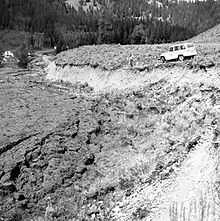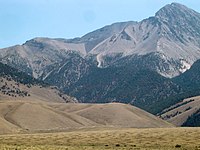Fault scarp: Difference between revisions
incorporate sources as inline citations |
No edit summary |
||
| Line 6: | Line 6: | ||
| footer = An eroded fault scarp from the [[Gobi Desert]] of [[Mongolia]] (left) and at [[Borah Peak]] in Idaho. The latter fault scarp (white line at the base of the tan hills) was formed in the [[1983 Borah Peak earthquake]] |
| footer = An eroded fault scarp from the [[Gobi Desert]] of [[Mongolia]] (left) and at [[Borah Peak]] in Idaho. The latter fault scarp (white line at the base of the tan hills) was formed in the [[1983 Borah Peak earthquake]] |
||
}} |
}} |
||
A '''fault scarp''' is a small step-like offset of the ground surface |
A '''fault scarp''' is a small step-like offset of the ground surface in which one side of a [[Fault (geology)|fault]] has shifted vertically in relation to the other.<ref>{{cite book |last1=Marshak |first1=Stephen |title=Essentials of geology |date=2009 |publisher=W.W. Norton |location=New York |isbn=978-0393932386 |edition=3rd}}</ref> The [[Topography|topographic]] expression of fault scarps results from the differential erosion of rocks of contrasting resistance and the displacement of land surface by movement along the fault.<ref name="Easterbrook">{{cite book |last1=Easterbrook |first1=Don J. |title=Surface Processes and Landforms |date=1999 |publisher=Prentice Hall |isbn=978-0-13-860958-0 |page=247 |url=https://www.google.com/books/edition/Surface_Processes_and_Landforms/J7oPAQAAIAAJ?hl=en&gbpv=1&bsq=%22fault+scarp%22+%22owe+their+topographic%22&dq=%22fault+scarp%22+%22owe+their+topographic%22&printsec=frontcover |language=en}}</ref><ref name="Smith">{{cite book |last1=Smith |first1=Bernard J. |last2=Whalley |first2=W. B. |last3=Warke |first3=Patricia A. |title=Uplift, Erosion and Stability: Perspectives on Long-term Landscape Development |date=1999 |publisher=Geological Society of London |isbn=978-1-86239-047-8 |page=111 |url=https://www.google.com/books/edition/Uplift_Erosion_and_Stability/VLSvQb3TzxkC?hl=en&gbpv=1&dq=%22Fault+scarp%22++displacement+of+the+land+surface&pg=PA111&printsec=frontcover |language=en}}</ref> Differential movement and subsequent [[erosion]] may occur along an old ''inactive'' geologic fault, or on a recent [[active fault]].<ref name="Holdsworth">{{cite book |last1=Holdsworth |first1=Robert E. |last2=Turner |first2=Johnathan P. |last3=London |first3=Geological Society of |title=Extensional Tectonics: Regional-scale processes |date=2002 |publisher=Geological Society of London |isbn=978-1-86239-114-7 |page=185 |url=https://www.google.com/books/edition/Extensional_Tectonics_Regional_scale_pro/qGI5V7VzKLsC?hl=en&gbpv=1&dq=%22fault+scarp%22+%22inactive%22+active+fault&pg=PA185&printsec=frontcover |language=en}}</ref><ref>{{cite book |last1=Babar |first1=Md |title=Hydrogeomorphology: Fundamentals, Applications and Techniques |date=1 January 2005 |publisher=New India Publishing Agency |isbn=978-81-89422-01-1 |pages=98-99 |url=https://www.google.com/books/edition/Hydrogeomorphology/HetiC6uWB2kC?hl=en&gbpv=1&dq=%22Fault+scarp%22++differential+movement&pg=PA98&printsec=frontcover |language=en}}</ref><ref name="Yorath">{{cite book |last1=Yorath |first1=C. J. |title=The geology of Southern Vancouver Island |date=2005 |publisher=Harbour Pub |location=Madeira Park, BC |isbn=9781550173628 |edition=Rev. 2005}}</ref> |
||
==Characteristics== |
==Characteristics== |
||
Revision as of 02:33, 13 May 2024
A fault scarp is a small step-like offset of the ground surface in which one side of a fault has shifted vertically in relation to the other.[1] The topographic expression of fault scarps results from the differential erosion of rocks of contrasting resistance and the displacement of land surface by movement along the fault.[2][3] Differential movement and subsequent erosion may occur along an old inactive geologic fault, or on a recent active fault.[4][5][6]
Characteristics
Fault scarps often contain highly fractured rock of both hard and weak consistency. In many cases, bluffs form from the upthrown block and can be very steep. The height of the scarp formation is equal to the vertical displacement along the fault. Active scarps are usually formed by tectonic displacement, e.g., when an earthquake changes the elevation of the ground and can be caused by any type of fault, including strike-slip faults, whose motion is primarily horizontal. This movement is usually episodic, with the height of the bluffs resulting from multiple movements over time. Displacement of around 5 to 10 meters per tectonic event is common.[7]

Due to the dramatic uplift along the fault, the fault scarp is very prone to erosion, especially if the material being uplifted consists of unconsolidated sediment. Weathering, mass wasting, and water runoff can soon wear down these bluffs, sometimes resulting in V-shaped valleys along runoff channels. Adjacent V-shaped valley formations give the remaining fault spurs a very triangular shape. This formation is known as a triangular facet; however, this landform is not limited to fault scarps.
Fault scarps may be only a few centimeters or many meters high. Fault-line scarps are coincident with faults, but are most typically formed by the erosion of weaker rocks that have been brought alongside more resistant ones by the movement along the fault. In the case of old eroded fault scarps, active erosion may have moved the physical cliff back away from the actual fault location which may be buried beneath a talus, alluvial fan or the sediments of the valley fill.
Examples
- The Teton Range in Wyoming is an example of an active fault scarp. The dramatic topography of the Tetons is due to geologically recent activity on the Teton Fault.[8]
- Fault scarps in Motosu, Japan, created by the 1891 Mino–Owari earthquake.
- The fault scarps bounding the East African Rift Valley.
- The fault scarps bounding the Rio Grande Rift in New Mexico.
References
- ^ Marshak, Stephen (2009). Essentials of geology (3rd ed.). New York: W.W. Norton. ISBN 978-0393932386.
- ^ Easterbrook, Don J. (1999). Surface Processes and Landforms. Prentice Hall. p. 247. ISBN 978-0-13-860958-0.
- ^ Smith, Bernard J.; Whalley, W. B.; Warke, Patricia A. (1999). Uplift, Erosion and Stability: Perspectives on Long-term Landscape Development. Geological Society of London. p. 111. ISBN 978-1-86239-047-8.
- ^ Holdsworth, Robert E.; Turner, Johnathan P.; London, Geological Society of (2002). Extensional Tectonics: Regional-scale processes. Geological Society of London. p. 185. ISBN 978-1-86239-114-7.
- ^ Babar, Md (1 January 2005). Hydrogeomorphology: Fundamentals, Applications and Techniques. New India Publishing Agency. pp. 98–99. ISBN 978-81-89422-01-1.
- ^ Yorath, C. J. (2005). The geology of Southern Vancouver Island (Rev. 2005 ed.). Madeira Park, BC: Harbour Pub. ISBN 9781550173628.
- ^ Strahler, Arthur N. (1960). Physical Geography (2nd ed.). New York: John Wiley & Sons, Inc,. p. 475.
{{cite book}}: CS1 maint: extra punctuation (link) - ^ Byrd, J.O.D., Smith, R.B., Geissman, J.W. (1994) The Teton fault, Wyoming: Topographic signature, neotectonics, and mechanisms of deformation, Journal of Geophysical Research (99), No. B10, p. 20095-20122


